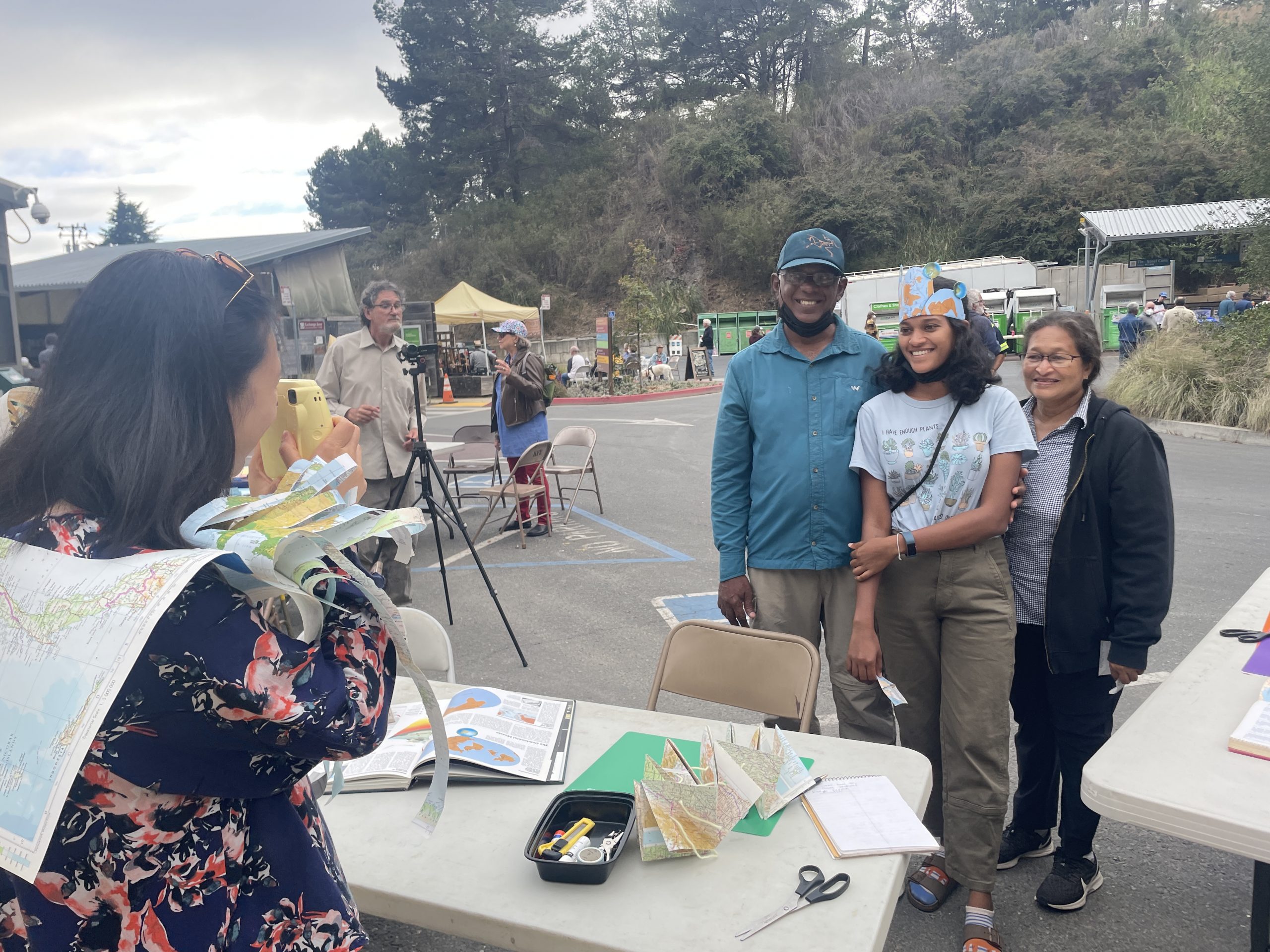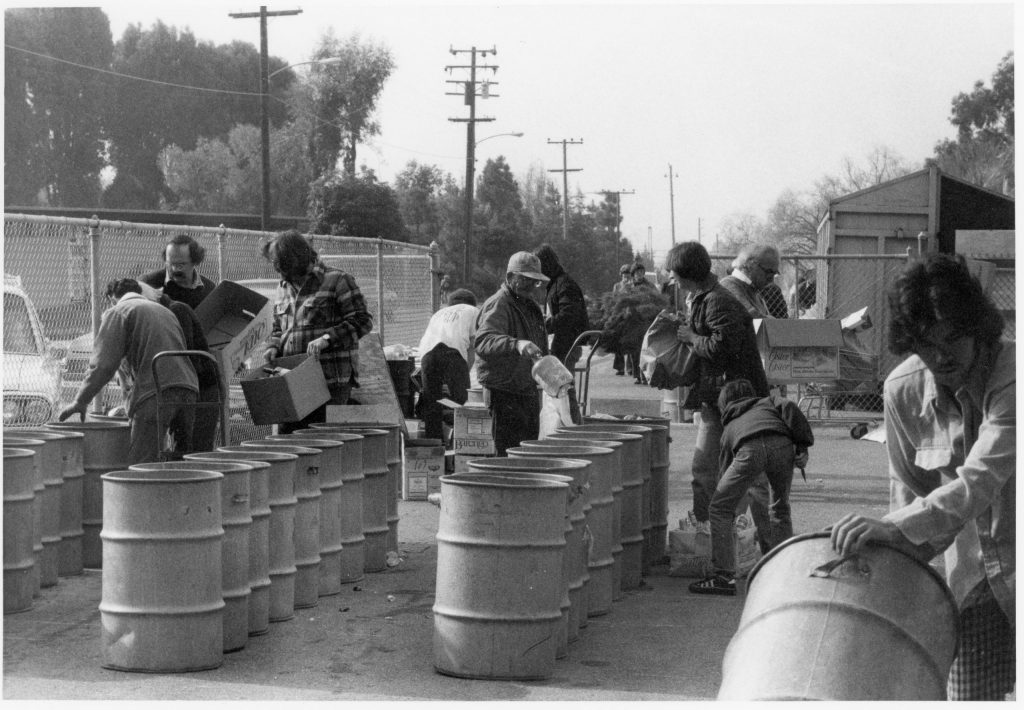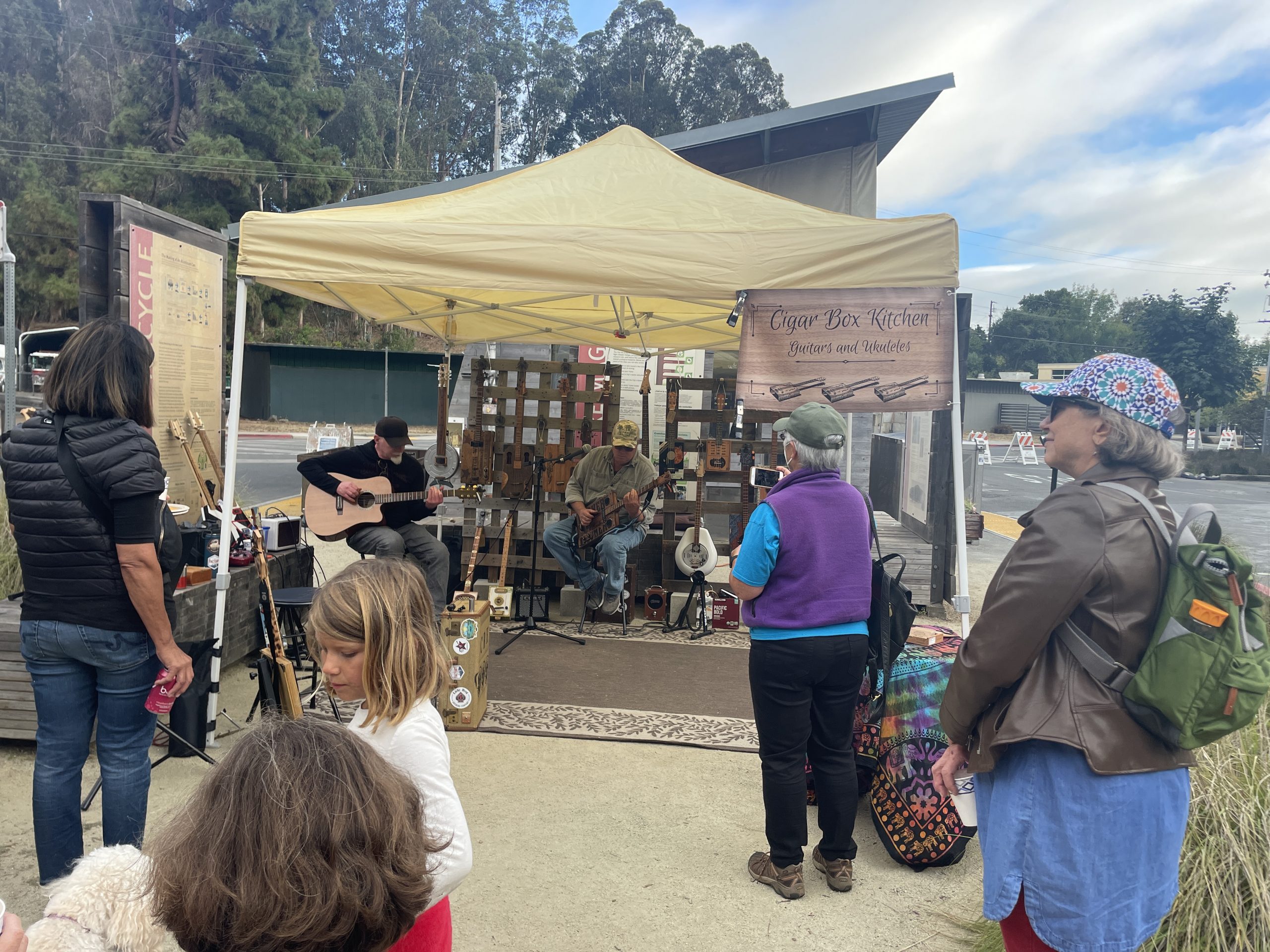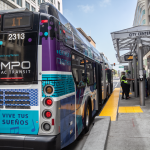
At the 50th anniversary celebration for the El Cerrito Recycling Center on Aug. 5, Anura Saliya Pieris of Sri Lanka made a hat for his daughter, Lakshmi, out of old atlases recovered from the center’s home-goods exchange zone.
Pieris had toured the beloved — Yes, beloved! — drop-off recycling center a few days earlier with his family while visiting his son, a software engineer in El Cerrito. As a corporate social responsibility manager, Pieris had plans to implement lessons learned upon return to his hometown of Borelesgamuwa near the Sri Lankan capital of Colombo.
“The circular design of the location enables the customers to drop their waste in a methodical manner, and the exchange center enables and encourages people to reuse things, such as to exchange books,” Pieris explains. “I’ll be able to introduce some of those things back in my country.”
Despite its small size, El Cerrito has had an outsize impact on recycling in the Bay Area and beyond for half a century. Located in a former quarry, the El Cerrito Recycling + Environmental Resources Center serves 300 to 500 customers daily and more than 100,000 people per year from El Cerrito and the surrounding region, diverting an estimated 1,500 tons of material from landfill annually. Combined with its curbside operations, the city of El Cerrito diverts 50% of its waste from the landfill; in California the rate is about 40% and nationally 30%.
The center is certified LEED Platinum by the U.S. Green Building Council and includes 10kW of solar photovoltaic panels, an 11,000-gallon rainwater cistern, native landscaping and rain gardens, an electric vehicle charger, and a prefabricated modular administrative building. In addition to sales of collected materials, the state-of-the-art center is supported by a fee on garbage bills, which most El Cerritans are happy to pay.
Pieris and his family believe they were the first visitors from Sri Lanka to tour the El Cerrito Recycling Center, but they definitely weren’t the first from overseas. The center has hosted more than 1,500 public and private tours since 2012, including international visitors from Japan, Brazil, Costa Rica, Northern Mariana Islands, Korea, and Guam.
“Prior to COVID, we had a constant flow of tours that included interested residents, neighbors, schools, organizations, and officials from our global community,” says Laurenteen Brazil, waste prevention specialist with El Cerrito’s Operations + Environmental Services Division. “People know about us through word of mouth and because they have visited us and have utilized our services. We also have strong historical ties within the recycling industry since we were one of the first such recycling centers, and maybe the only one like this nationwide.”

El Cerrito Recycling Center (foreground) viewed from Hillside Park.
Circular design reflects recycling ethos
The center underwent a $3.5 million redesign in 2012, which emphasized green infrastructure and ease of use. Collection bins are arranged in a semi-circle — mirroring the circularity of reduce, reuse, and recycle — with cars backing in to distribute materials ranging from paper, cardboard, glass, and cans to electronics, steel, planters, and used kitchen oil.
“We were very pleased with how much the infrastructure itself embodied the idea of recycle and reuse,” says Garth Schultz, recycling center manager from 2006 to 2014.
“At the time we did it, it was one of a kind,” says Janet Abelson, El Cerrito city council member since 1999 and five-time mayor. “We have the circle and around the circle there are all these different ways to segregate and recycle materials. The ultimate goal was to be able to recycle everything so that there’s no waste.”
Most of the drop-off areas are open to all comers six days a week. Residents in the West Contra Costa Integrated Waste Management Authority’s RecycleMore service area (El Cerrito, Hercules, Pinole, Richmond, San Pablo, and surrounding unincorporated communities in Contra Costa County) can also bring in hard-to-dispose-of items such as medicine and needles (people living outside those areas can pay a fee to drop-off these items). The facility also offers RecyleMore area residents free household hazardous waste collection on Tuesdays and El Cerrito residents can recycle styrofoam on Thursdays.
The busy exchange zone helps find new homes for books, corks, hangers, and a variety of small home goods. Trucks and bins collect used clothing, furniture, toys, and the like, which are resold by thrift stores. Plus, there are drop-off barrels for local food banks. The center even hosts artists-in-residence, who “upcycle” discarded items into creative works.
And helpful city staff are always on hand to answer questions. “Recycling, when you get deeply into it, can be confusing. There’s so much greenwashing out there,” Brazil says. “As a one-stop shop, our mission is to make recycling convenient and easy.”
“As a consumer, that’s a relief,” she continues. “It’s nice to know that they can call someone and see if there is a use for the thing that they have. It helps them feel that they’ve done their part for the environment to keep useful things out of the landfill.”

Sarah Steele, daughter of Joel Witherell, speaks at EC Recycling’s 50th anniversary celebration.
Where recycling is a pleasure
In his definitive 62-page history, “Where Recycling is a Pleasure,” David Weinstein, president of the El Cerrito Historical Society, described the center’s founding by community activists in 1972, two years after the first Earth Day. A nonprofit in Berkeley had opened a small drop-off center in 1970 at a time when “recycling” was almost unknown in the Bay Area or beyond, Weinstein wrote. So, El Cerrito’s drop-off recycling center wasn’t actually the first, but it was definitely the first with strong support from its community and city council.
“We sat around a table and were talking about why we shouldn’t have a recycling center instead of every can and bottle being thrown in the dump, which offended us,” Virginia Rice Mason told Weinstein in an interview. One of those sitting around the table was Ken Little, who came up with the center’s original name, “E.C.ology.” Also at the table was Nancy Gans, who apparently received an exemption from paying the city’s garbage collection fee because she literally recycled everything.

Recyclers sort into correct bins. Photo: El Cerrito Historical Society (1977).
“For El Cerrito, it was the start of something grand,” wrote Weinstein, who spearheaded the 50th anniversary celebration. “More than a recycling operation, it became a love affair. No. It was better than that. It became a marriage of the best sort — a till-death-do-us-part kind of thing.”
Thirty-three people dropped off bottles and cans during a rainstorm on the center’s first day of operation, August 5, 1972. On October 7, 250 people brought materials and there was enough income to start paying teenage bottle smashers $2 an hour.
Things really took off when El Cerrito hired Joel Witherell as its parks and recreation director in 1973; he went on to champion the city’s pioneering recycling operations for 20 years. “No one did more than Witherell to keep recycling going in El Cerrito,” Weinstein noted.
The El Cerrito Recycling Center was primarily run by volunteers — including local Boy Scout troops, who collected newspapers from residents, and people completing court-ordered community service — until 1977, when the city took over with the goal of eventually recycling 25% of residents’ waste. That same year, El Cerrito became the 6th city in California to offer curbside pickup of recycling for a fee of $1 per month per participating household.
“The city’s takeover of E.C.ology was the decisive moment in the recycling center’s history,” Weinstein wrote. “Relatively few cities have ever run their own recycling centers, and although many volunteer, nonprofit groups have run recycling centers, few of those have lasted into the present.”
Several task force reviews in the mid-2000s led to El Cerrito’s major investment in the center. “Every time we asked the public, they always expressed how much they loved it and how much of a resource it was,” Schultz says.

Artist-in-residence Steve Zwetch and friends play “upcycled” instruments.
Sentimental about recycling
Back at the 50th anniversary celebration, people listen to music on guitars and ukuleles made out of found items by El Cerrito Creative Reuse artist-in-residence Steve Zwetsch; former artists-in-residence Kloe Chan and Risa Dye encourage visitors, including the Pieris family, to make something to wear out of old atlases; and old-timers reminisce about the heady early days of the El Cerrito Recycling Center.
Gregg Cook, El Cerrito’s mayor when E.C.ology got started, says that despite strong community and city support, the recycling center did have opponents. “The folks who owned the landfill didn’t like this idea worth a damn. They were paid for every ounce that was dumped in their landfill.”
And Allan Gardiner, an engineer who built the center’s original glass crusher in the early 1970s, reminisced that recycling has come a long way since the days when it cost a nickel to use a pay toilet; you could see San Francisco across the bay from El Cerrito “maybe 4 days a year”; and the milkman was the only person in town reusing bottles.
“It’s hard to get sentimental about recycling,” Gardiner tells more than 80 people celebrating El Cerrito’s state-of-the-art recycling center in an old rock quarry. “But what’s gratifying is that there are so many people here who are sentimental about recycling.”
Top photo: (Left to right) Anuri, Lakshmi (with her atlas hat), and Parami Pieris.
Photos by Janet Byron unless otherwise noted.

